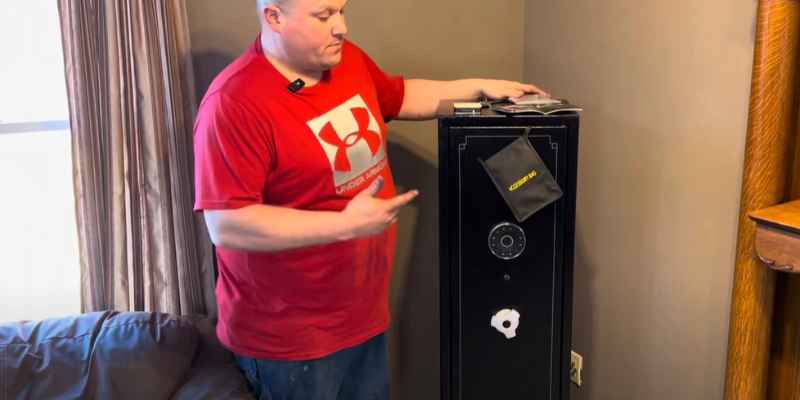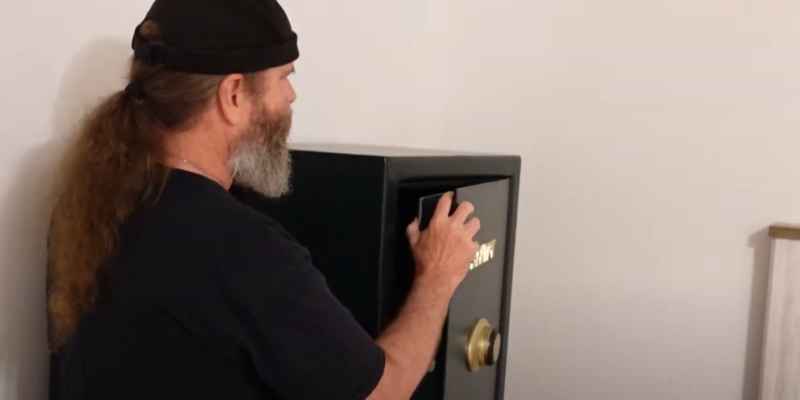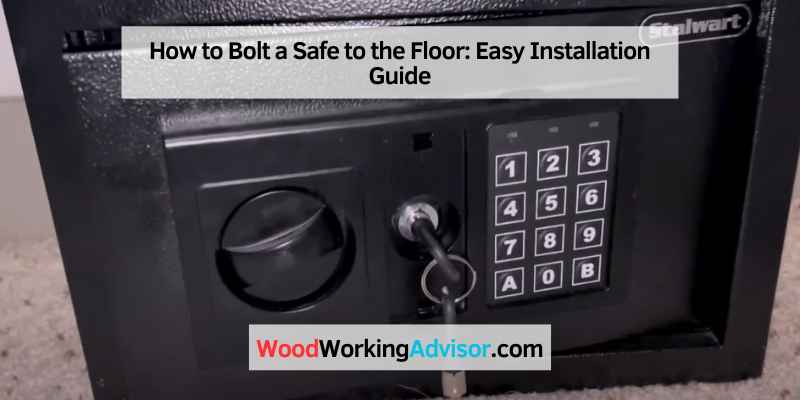To attach a safe to the floor, align the holes in the bottom of the safe with the ones in the floor, then install the bolts or screws through the holes and secure them using washers or the recommended fasteners for the installation. For concrete floors, use masonry anchors.
However, before attaching a safe to the floor, it is essential to ensure that the safe can be accessed easily and that the floor can support the weight of the safe. This article provides all the necessary steps to install a safe correctly, ranging from preparing the safe, drilling the holes, inserting the bolt, and ensuring the safe is sturdy.
Additionally, it offers insights into the kind of anchors to use for the safe’s installation, the type of floor suitable for a safe, and how to prevent the safe from tipping over.

Preparing To Bolt Your Safe
Attaching a safe to the floor requires careful preparation to ensure the safety of your home and its contents. Install anchor bolts or masonry anchors through the safe’s bottom holes, securing them with washers for added stability. Safes should be bolted down to prevent tipping or falling during natural disasters, burglaries or accidents.
If you have invested in a safe, then it is crucial to bolt it down for added security. Bolting a safe to the floor prevents it from being easily moved or stolen. However, before you start with the bolting process, it is important to prepare your safe first. In this section, we will discuss the steps you need to follow before bolting your safe down.
Ensure Safe Accessibility
You need to ensure that the safe is positioned in a place where it can be accessed easily. This means that you should choose an area that is not obstructed by other items, such as furniture or appliances. Additionally, consider the needs of the people who will use the safe. Will they be able to open the safe comfortably? Will they have enough room to maneuver around it?
Checking For Electrical And Plumbing Runs
Before you start drilling holes into the floor, you need to check if there are any electrical or plumbing runs underneath. Drilling into these pipes or wires can cause serious damage and can be costly to repair. You can easily check for these runs by using a stud finder or by consulting a professional.
Preparing The Safe
Once you have selected the perfect spot and checked for electrical and plumbing runs, it is time to prepare your safe for bolting. Start by removing any shelves that might be inside the safe, as well as any items that are currently stored inside. Also, ensure that the holes in the bottom of the safe are aligned with those on the floor.
Drilling Holes And Anchoring
Using a drill bit that is appropriate for your flooring material, drill holes into the floor at the marked position. For concrete floors, use masonry anchors to secure the bolts into the floor. For wooden floors, use wood screws or anchor bolts. Make sure that the bolts are tightened securely to prevent the safe from moving or tipping over.
By following these steps, you will be able to prepare your safe for bolting and ensure that it is bolted down securely. Make sure to keep the safe keys and combinations in a safe place, so that you can always access your valuables when you need them.
Bolting Your Safe To A Concrete Floor
Attaching a safe to the floor is important to ensure the safety of the contents inside, especially if it contains loaded firearms or dangerous items. The process involves drilling holes into the concrete floor and using masonry anchors to secure the safe in place.
Make sure to check for electrical or plumbing runs before drilling and use recommended fasteners for the specific safe installation.
One of the most important steps to ensure the safety of your valuables is to bolt the safe to the floor. This will not only prevent thieves from stealing the safe but also prevent it from falling over and causing damage or injury. In this blog post, we will guide you through the steps to bolt your safe to the floor by focusing on drilling holes in the floor and inserting concrete screws.
Drilling Holes in the Floor
The first step to bolt the safe to the floor is to drill holes in the concrete. The size and number of holes depend on the size and weight of the safe. You can use a hammer drill and masonry bit to drill the holes, but make sure to wear safety goggles and a mask. The holes should be at least two inches deep and slightly wider than the diameter of the screw or anchor you will be using.
H3: Inserting Concrete Screws
Once the holes are drilled, it’s time to insert the concrete screws. The screws you use should be specifically designed for use on concrete surfaces and should be long enough to reach the depth of the hole. Be sure to follow the manufacturer’s instructions and use the recommended type and size of screw.
To insert the screws, you can use a socket wrench or impact driver. Tighten the screws until they are snug and secure. It is important not to overtighten the screws as this can strip the threads in the concrete and weaken the hold.
Conclusion
In conclusion, bolting your safe to a concrete floor is a crucial step to ensure the safety of your valuable possessions. By drilling holes in the floor and inserting concrete screws, you can secure the safe in place and prevent it from being easily stolen or tipped over. Just be sure to follow the manufacturer’s instructions and use the recommended screws and anchors for your specific safe and concrete floor.
Bolting Your Safe To A Wooden Floor
Attaching a safe to a wooden floor is important for security reasons. To do so, you need to align the holes in the bottom of the safe with the ones in the floor and use washers or recommended type of fasteners to secure your safe in place, especially if the safe contains firearms or dangerous items.
Make sure to avoid putting your safe directly on a concrete floor due to the potential for moisture damage.
One way to keep your safe secure is to bolt it to the floor. Attaching your safe to a hardwood floor can be an effective way to prevent burglars from walking away with the entire safe. And while a concrete floor is the most common material to bolt your safe to, bolting your safe to a wooden floor can be just as secure if done correctly.
Drilling Holes in the Floor
The first step in securing your safe to a wood floor is to drill holes into the floor. Be certain to use a drill bit that is slightly smaller than the screws that you plan to use. This will allow the screws to fit snugly into the holes and secure the safe.
Inserting Wood Screws
After drilling the holes, insert the wood screws and tighten them down with a screwdriver. Make sure to use the correct type and size of screws recommended for your safe. Lastly, ensure that each screw is secure and flush with the floor.
Another helpful tip is to drill and anchor through the base of the safe. Some safes come equipped with pre-drilled holes, but if your safe does not, make sure to drill a hole through the bottom of the safe base and then attach the safe to the floor through the hole.
Bolting your safe to a hardwood floor not only secures your belongings but can also give you peace of mind, especially if you live in an area with a high crime rate. Remember to follow these tips and consider seeking professional assistance if you are unsure about how to safely and correctly bolt your safe to the floor.

Additional Steps
Attaching a safe to the floor is an important security measure to prevent theft or accidental tipping. To ensure a safe and successful installation, you may need to drill holes, insert anchors and secure the safe with bolts or screws recommended for the installation.
Follow instructions carefully and consider the weight of the safe and type of the floor.
Additional Steps to Secure Your Safe:
Aside from aligning and drilling holes on the safe and the floor, there are additional steps that can ensure sturdiness and usability of the safe. Follow these H3 subheadings for a more comprehensive guide.
If your safe requires more storage space or compartments, consider adding shelving. You can customize the size of each shelf according to your storage needs. Alternatively, you can purchase ready-made shelves that can securely attach to the walls of your safe.
Ensuring Sturdiness
After bolting your safe to the floor, be sure to check its sturdiness. Test its stability by exerting pressure on each side and corner of the safe. Make sure it doesn’t wobble or shift even when fully loaded with your valuables.
In conclusion, attaching a safe to the floor doesn’t just involve drilling and bolting. Additional steps such as adding shelving and ensuring sturdiness can make a big difference in securing your valuables. Following these steps will give you peace of mind knowing that your safe is secure and your valuable items are protected.
Frequently Asked Questions On How To Attach A Safe To The Floor
Can You Mount A Safe To The Floor?
Yes, you can mount a safe to the floor by aligning the holes in the bottom of the safe with the ones in the floor, then installing bolts or screws through the holes and securing them using washers or recommended fasteners.
It is critical to bolt the safe down to prevent injury and ensure it does not tip over. Use masonry anchors for concrete floors and avoid placing the safe directly on concrete to prevent moisture damage.
Does A Safe Need To Be Bolted Down?
Yes, it is highly recommended to bolt down a safe to the floor to prevent it from tipping over and potentially causing injury. The safe should be aligned with the holes in the floor and secured with bolts or screws, using masonry anchors for concrete floors to ensure stability.
It is not advisable to place the safe directly on concrete as moisture can damage the safe and its anchors.
Should I Put My Safe Directly On Concrete?
It is not recommended to put your safe directly on concrete as it can cause moisture to build up and damage the safe due to corrosion. Bolting the safe to the floor is critical for safety, but be sure to use masonry anchors for concrete floors to avoid destroying the anchors due to excess moisture.
How Heavy Of A Safe Can My Floor Support?
Make sure to consult with a professional to accurately determine the weight your floor can support. Typically, a safe weighing up to 1,000 pounds can be supported by most floors. It’s important to also properly bolt the safe to the floor using recommended fasteners, and to avoid mounting on moisture-prone concrete floors.
Always follow manufacturer recommendations to prevent injury and damage.
Conclusion
A good idea to prevent any potential theft or mishaps. Make sure to carefully follow the steps outlined above to properly secure your safe to the floor. Remember to use the appropriate tools and fasteners based on the type of floor surface you have.
By taking this extra precaution, you can have peace of mind knowing that your valuable items are securely locked and attached to the floor.


